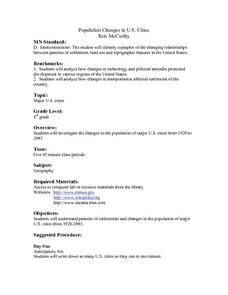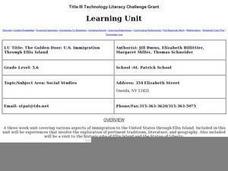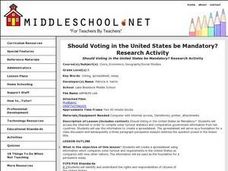Curated OER
South Carolina State Quarter
In this South Carolina worksheet, learners analyze a picture of the state quarter for South Carolina. Students use the information on the coin to answer five questions.
Curated OER
Texas State Quarter
In this Texas instructional activity, students analyze a photo of the state quarter of Texas. Students answer 7 questions about Texas using the information on the coin.
Curated OER
Imperialism and Expansion: Part 1
Pupils explore the era of imperialism and expansion of the United States. In this American history lesson, students play a game regarding the U.S. attempts to expand the nation in the late 1800s and early 1900s.
Curated OER
Using History to Teach Tolerance: A Ripple of Hope
Students investigate the prejudice and racism that has existed in the U.S. for centuries by attending a field trip. In this equality lesson, students visit the Tolerance Museum and discuss the history of the U.S. Students...
Curated OER
Immigrants to Kansas: Why Did They Come
Students explore U.S. History by researching Kansas. In this immigration lesson, students discuss the benefits of immigrating to a state like Kansas in the 1800's while writing their thoughts and research in a reporter's notebook....
Curated OER
History and Government of the United States
In this U.S. worksheet, students take notes in a graphic organizer as they read several passages, then answer four comprehension questions.
Curated OER
Puerto Rico: The 51st State?
Students examine the political status of Puerto Rico. In this global studies lesson, students explore Puerto Rico and consider the feelings of Puerto Ricans regarding their unique political status.
Curated OER
Making a Travel Folder
Students explore the United States. For this U.S. geography and expository writing lesson, students select a place in the United States to research. Students take notes and create a travel "folder," or brochure, using the...
Curated OER
Population Changes in U.S. Cities
Students investigate the changes in the population of major U.S. cities from 1920 to 2003. They write down as many U.S. cities as they can in one minute. Students discuss the top five cities on their lists and they disucss why there are...
Curated OER
The U.S. Recognition of the State of Israel
Students research the political aspects of the U.S. position in the Middle East, considering, for example, Truman's position in view of the 1948 presidential election. They examine a telegram sent by the Secretary of State, George C....
Curated OER
Rhode Island State Map
In this geography of Rhode Island worksheet, students color and label a map with the major cities and physical features. Students also study a U.S. map to learn the location of the state of Rhode Island.
Curated OER
German Energy Conversations
High schoolers identify and interpret the current German energy mix and trends, as well as to make comparisons and contrasts to that of their own country. They write a two paragraph description of including its likely position in the...
Curated OER
Life During the Civil War for Women and Civilians
Students follow an overview of the American Civil War from a film, the text and/or teacher direct instruction. They create a timeline with a large map of the U.S. in the 1860's available for student reference as they do the spider activity.
Curated OER
The Golden Door: U.S. Immigration Through Ellis Island
Young scholars complete a unit covering various aspects of immigration to the United States through Ellis Island. They plan a fictional trip to America, entering at Ellis Island. and actually visit Ellis Island and the Statue of Liberty.
Curated OER
State Report
Students create a state report/ presentation. They research U.S. state information using the Internet and retrieve information about specific topics (Individual States in the USA) using technology resources.
Curated OER
Geography Puzzles
Learners study the continents of the world. In this Internet geography lesson, students connect to online mapping games. Learners collaborate in order to develop their understanding of world geography, including countries and capital...
Curated OER
Establishing Borders: The Expansion of the United States 1846-48
Students investigate how the United States acquired land after the Revolutionary War ended. In this establishing borders instructional activity, students use maps to identify territories acquired by the US and the states that later...
Curated OER
Maps
Maps, globes, and computer software aid young explorers as they locate state capitols, major cities, geographic features, and attractions for states they are researching. They then use desktop publishing software to create a map to share...
Curated OER
Operation Immigration
Fifth graders create a digital scrapbook depicting the life and journey of an immigrant to the United States. Individuals will use the internet as a tool to research immigration in the U.S., and videos and guest speakers help students...
Curated OER
Alaska Virtual Field Trip
Students participate in an on-line virtual field trip to the state of Alaska. In this U.S. Geography instructional activity, students research several Internet sites dealing with travel to Alaska and activities to participate in....
Curated OER
To Be Or Not To Be a State? That Is the Question
Eighth graders research Puerto Rico's culture, religion, language, government, etc. and identify differences and similarities with the United States. They participate in a debate about whether or not Puerto Rico should become a state.
Curated OER
Should Voting in the United States be Mandatory? Research Activity
Eighth graders research how many voters actually vote in the U.S. and nine other nations. They create a spreadsheet using this information and write a persuasive essay.
Curated OER
Overland Trails To The West
After observing a map of trails that settlers took in the 1800s, your class will write a journal with the perspective of a settler. In their journals, they must describe the trail they traveled, geographical features they saw, states and...
Curated OER
Where Do I Live?
Students gain a better understanding of the population of the region they live in by comparing U.S. census data on the internet.























